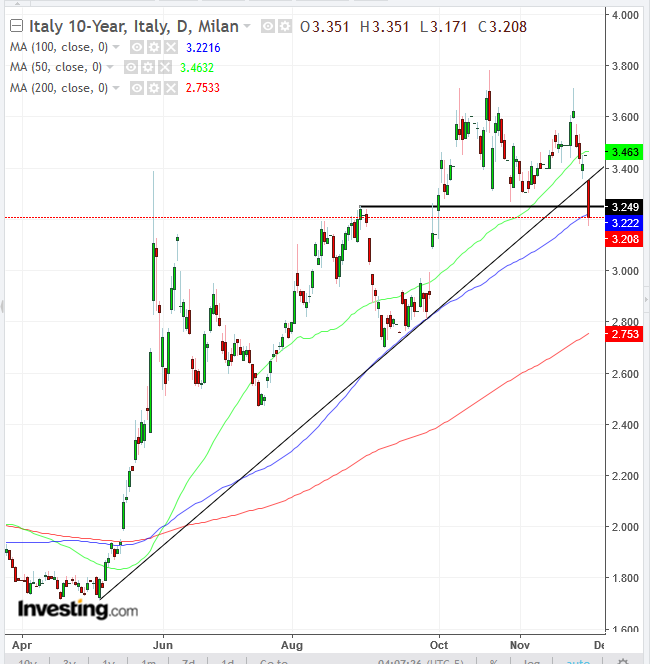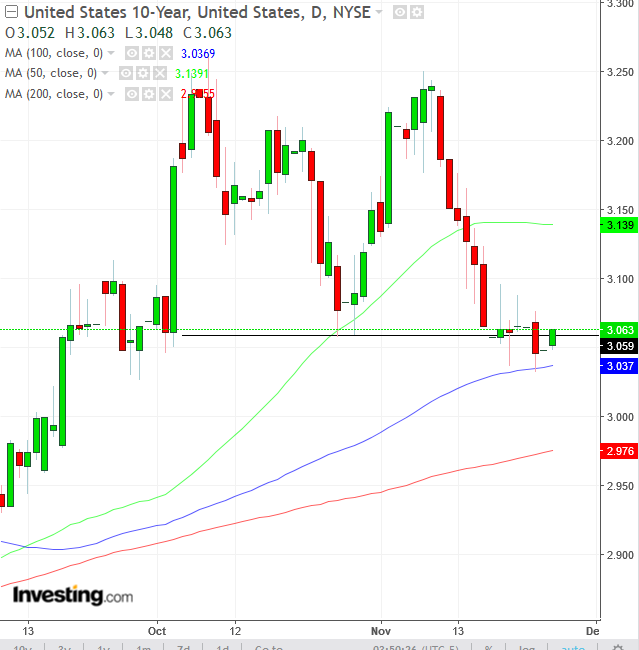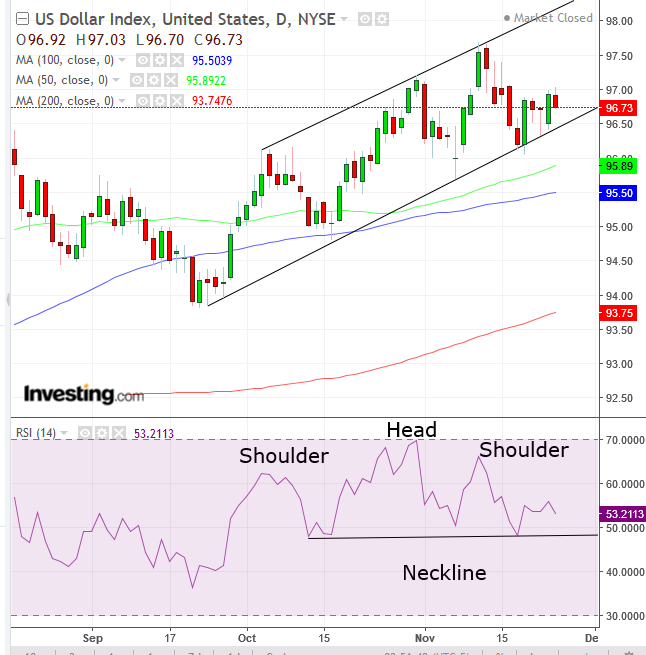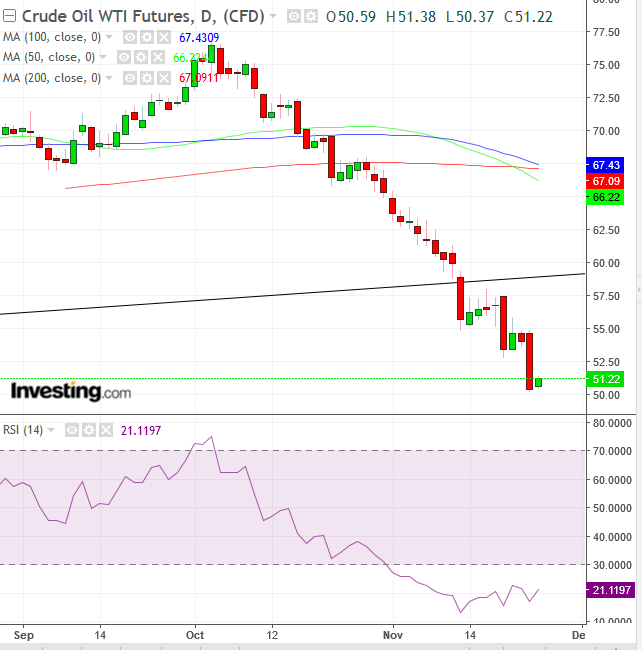- US futures, global stocks rally on risk-on shift
- Italian bonds leap forward on potential tweaks to budget, boosting the euro
- Falling Treasurys drag down the dollar, reducing pressure on oil
- Bitcoin struggles after falling to 14-month low
Key Events
Investors sought risk on Monday, pushing most Asian and European shares higher along with futures on the S&P 500, Dow and NASDAQ 100, wiping out Thursday’s and Friday’s declines. US Treasurys fell on the renewed risk-on sentiment, weighing on the dollar, which in turn reduced pressure on oil, propping it back above $51. The yen, too, slid on renewed risk appetite.
The STOXX Europe 600 climbed, with banks and energy companies leading gains across the board.

While core bonds in Europe slipped, Italy’s sovereign debt jumped after the country’s Deputy Premier Matteo Salvini signaled the government may be open to altering the country’s budget deficit target for next year, boosting the euro as well. Technically, Italy's 10-year yields, down over 5 percent in the late European morning session, topped out. The pound, meanwhile, was mildly higher after European Union leaders approved the Brexit draft put forward by UK Prime Minister Theresa May as the "best and only possible deal."
In the earlier Asian session, stocks advanced. Tokyo’s Nikkei 225 (+0.69%), Seoul’s KOSPI (+1.24%) and Hong Kong’s Hang Seng (1.73%) all moved higher, though China’s Shanghai Composite (-0.14%) and Australia’s S&P/ASX 200 (-0.78%) bucked the positive trend. Most sectors on the MSCI Asia Pacific Index closed in positive territory as well, with technology—the sector that has been pounding US markets for much of the past eight weeks—outperforming.
Global Financial Affairs
US equities slipped lower on Friday. The S&P 500 officially joined the NASDAQ and Russell 2000 in a correction, leaving the Dow Jones Industrial Average as the only US major not yet in official correction territory, though its performance during the holiday-shortened week was its third worst Thanksgiving week performance since 1939.
The backdrop of slowing demand coupled with growing supply sent WTI prices spiraling toward the $50-mark, wreaking havoc on oil producers, which in turn weighed on the broader stock market. While fundamentals are still solid, technicals have been raising red flags.

Treasury yields climbed, as investors shed safer trades in favor of equity risk. Technically, 10-year yields are squeezed between the resistance of a double top’s neckline and the 100 DMA.

Falling yields dragged the dollar lower. Technically, the greenback is consolidating at the bottom of its rising channel. Note the weakening momentum, as the RSI forms a potential H&S bottom. Its downside breakout would suggest that prices may follow lower.

WTI's 6.66 percent drop on Black Friday might have been considered ominous by some. Fundamentally, however, a weakened USD took some pressure off the commodity.
Technically, the price may have found support above the $50 psychological round number. Also, the RSI is climbing after reaching the extreme low level of 13, its most oversold condition in years. However, prices eased after crossing their long-term uptrend line since the February 2016 bottom of $26.05 almost two weeks ago. The 50 DMA executed a Death Cross, with the 50 DMA crossing below the 200 DMA, a technical milestone that receives significant attention on Wall Street, even among fundamental analysts. On a weekly basis, after falling for 8 straight weeks, the price fell below the 200 WMA, currently at $52.19.
Bitcoin struggled around the $4,000 round psychological level, after reaching a low of $3,663 yesterday—the lowest price for the cryptocurrency in fourteen months, as we forecast.
Markets will now turn their attention to Fedspeak and minutes, due out later today from the Fed's last policy meeting, which may help investors formulate their interest rate outlook for 2019.
Bond traders have reduced bets on the Fed's rate tightening pace. Chair Jerome Powell will have the opportunity to clarify his position in a speech on Wednesday. A second item on the Fed's agenda is its $4.1 trillion balance sheet—something that doesn’t get as much attention but carries far-reaching consequences for a wide range of factors, from the Treasury’s borrowing needs to overall bank reserves to how the Fed controls its policy rate. In August, policymakers hinted they might discuss their plans for the central bank's portfolio before the end of the year, so some analysts will scrutinize minutes from the November meeting in search of further signals.
Meanwhile, a crucial meeting between Chinese President Xi Jinping and US President Donald Trump, amid looming tariff deadlines, is sure to reverberate across markets, one way or another. Should they reach some sort of trade agreement, US equity markets are expected to get back on track and extend the longest bull run on record.
Up Ahead
- European Central Bank President Mario Draghi will address the European Parliament’s committee for economic and monetary affairs on Monday while ECB Chief Economist Peter Praet also speaks at a conference in Frankfurt.
- Presidents Trump and Xi Jinping are scheduled to meet at the G-20 summit kicking off in Argentina on Friday.
- Federal Reserve Vice Chairman Richard Clarida speaks in New York on Tuesday and Chairman Jerome Powell addresses the New York Economic Club on Wednesday.
- Thursday sees the release of the minutes from the Federal Open Market Committee’s November meeting.
Market Moves
Stocks
- The Stoxx Europe 600 climbed 0.9 percent, the highest level in more than a week.
- Futures on the S&P 500 gained 0.9 percent to the highest level in a week on the biggest rise in more than a week.
- Italy’s FTSE MIB surged 2.5 percent to the highest level in almost two weeks on the largest jump in more than five months.
- The UK’s FTSE 100 edged 0.8 percent higher.
- The MSCI All-Country World Index climbed 0.3 percent.
Currencies
- The Dollar Index dropped 0.24 percent, paring half of Friday’s advance.
- The euro gained 0.3 percent, the largest gain in a week.
- The British pound climbed 0.2 percent to $1.2834.
- The Japanese yen dropped 0.3 percent to 113.27 per dollar, the weakest level in more than a week.
Bonds
- The yield on 10-year Treasuries gained two basis points to 3.06 percent, the biggest climb in almost three weeks.
- Italy’s 10-year yield fell 17 basis points to 3.24 percent, the lowest in almost two months on the largest dip in more than five weeks.
- Germany’s 10-year yield climbed two basis points to 0.36 percent.
- Britain’s 10-year yield gained two basis points to 1.406 percent.
Commodities
- West Texas Intermediate crude advanced 1.3 percent to $51.09 a barrel.
- Brent crude jumped 1.9 percent to $59.89 a barrel, the largest surge in eight weeks.
- Copper dropped less than 0.05 percent to $2.79 a pound.
- Gold increased 0.3 percent to $1,227.22 an ounce.
